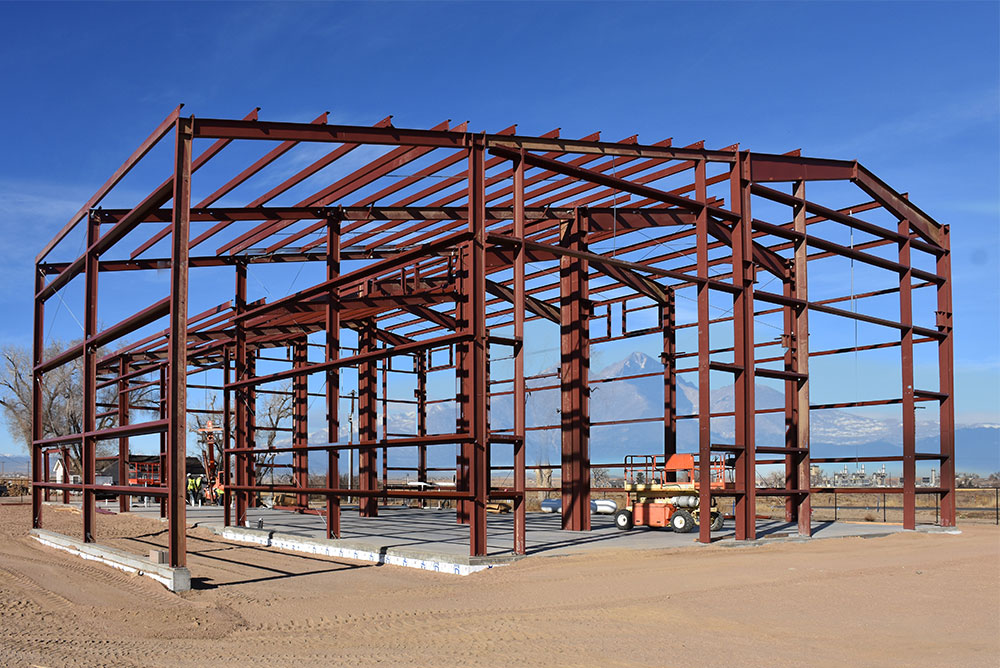Specialist Guide to Steel Structure Design: Making Best Use Of Effectiveness and Longevity
In the world of building and construction, the choice of structure product holds critical importance in identifying the effectiveness and durability of a structure. Steel, with its phenomenal strength, toughness, and convenience, has emerged as a preferred choice for modern-day structure layout. Designers and engineers are continually exploring ingenious methods to harness the capacity of steel in building long-lasting and sustainable structures. From optimizing style factors to consider to executing cost-efficient construction strategies, the trip in the direction of optimizing performance and long life in steel structure style is a complex one, offering a mix of functional difficulties and imaginative solutions that move the industry forward.
Advantages of Steel Structures
Steel structures provide unrivaled longevity and cost-effectiveness compared to typical building products. The stamina of steel provides outstanding architectural integrity, making it a favored selection for buildings that need to hold up against severe climate problems or hefty loads.
In terms of cost-effectiveness, steel buildings are usually a lot more budget friendly than structures made from other products. The reliable building procedure of steel buildings can cause reduced labor costs and shorter job timelines. Steel's durability also converts to decrease upkeep expenditures with time, as there is much less need for replacements or repairs compared to traditional structure materials.
Design Considerations for Performance
Provided the advantages of steel structures in terms of toughness and cost-effectiveness, it is important to focus on design factors to consider that optimize efficiency and durability. When designing a steel structure for optimum efficiency, variables such as the design, insulation, and alignment must be meticulously considered.

Moreover, integrating energy-efficient systems, such as a/c, illumination, and renewable resource resources, can additionally improve the efficiency of steel structures. By integrating these design factors to consider, steel structures can accomplish optimum performance and longevity, giving sustainable and economical remedies for numerous building and construction tasks.
Structural Integrity and Longevity

Furthermore, the selection of high-quality steel and layers is vital for longevity. Corrosion-resistant coatings secure against corrosion and wear and tear, lengthening the life of the structure. Normal maintenance, including assessments for indicators of wear or damage, is likewise critical for recognizing and resolving concerns before they jeopardize the structure's honesty. By prioritizing structural integrity in the design phase and throughout the building's life expectancy, owners can guarantee their steel frameworks continue to be secure, efficient, and durable for years to find.
Cost-Effective Construction Techniques
Efficient construction methods play a pivotal duty in managing costs without endangering the top quality and stability of steel building jobs. Additionally, pre-engineered steel structures are known for their toughness and require marginal maintenance, resulting in long-term price financial savings.
An additional economical method is the design-build method, where the design and building and construction phases sites are integrated. This approach cultivates partnership between the layout and building and construction groups, enhancing the process and minimizing delays and expense overruns (steel buildings). By entailing all stakeholders initially, prospective concerns can be recognized and fixed early, saving both time and cash
Furthermore, taking on sustainable building and construction methods, such as utilizing recycled steel and incorporating energy-efficient attributes, can bring about significant price savings over time. These practices not only lower building waste but additionally lower functional prices with enhanced power performance. In final thought, executing cost-effective building and construction methods is necessary for making best use of efficiency and making sure the long life of steel building projects.
Upkeep Tips for Longevity
Appropriate maintenance methods are vital for guaranteeing the durability and architectural honesty of steel structures. Routine assessments are necessary to identify any type of indicators of deterioration, damage, or wear that can compromise the structure's resilience. As part of a detailed upkeep plan, it is essential to quickly attend to any type of concerns that arise to stop them from rising and triggering much more substantial damage.

Another essential upkeep tip is to evaluate the building's welds, bolts, and links to ensure they are secure and in great condition. Any type of loosened or damaged components need to be repaired or replaced immediately to maintain the structural stability of the structure. By implementing a proactive upkeep regimen, steel building owners can make the most of the long life and efficiency of their structures.
Conclusion
To conclude, steel buildings supply the original source various benefits such as durability, cost-effectiveness, and performance. By carefully thinking about style facets, guaranteeing architectural honesty, and making use of cost-efficient building and construction techniques, steel structures can be optimized for optimal performance and longevity. Normal upkeep is additionally crucial to ensuring the longevity of a steel building. Overall, steel structures are a reputable and sturdy alternative for numerous construction projects.
From maximizing design considerations to implementing cost-effective building techniques, the trip towards making best use of efficiency and durability in steel structure style is a diverse one, supplying a mix of useful obstacles and creative options that push the industry ahead.
Offered the advantages of steel buildings in terms of click here for more info durability and cost-effectiveness, it is crucial to focus on style factors to consider that take full advantage of efficiency and durability. When making a steel structure for ideal efficiency, aspects such as the format, orientation, and insulation need to be carefully taken into consideration. In final thought, applying cost-effective building techniques is necessary for optimizing performance and making certain the long life of steel structure tasks.
By carefully considering design aspects, making certain structural integrity, and utilizing cost-effective building and construction approaches, steel structures can be maximized for optimal effectiveness and longevity.